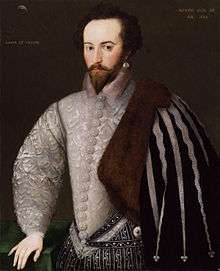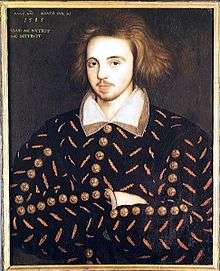The School of Night


The School of Night is a modern name for a group of men centred on Sir Walter Raleigh that was once referred to in 1592 as the "School of Atheism". The group supposedly included poets and scientists Christopher Marlowe, George Chapman and Thomas Harriot. There is no firm evidence that all of these men were known to each other, but speculation about their connections features prominently in some writing about the Elizabethan era.
Name
.jpg)
Raleigh was first named as the centre of "The School of Atheism" by the Jesuit priest Robert Persons in 1592,[1] but "The School of Night" is a modern name; the theory that this so-called school was a clandestine intellectual coterie was launched by Arthur Acheson, on textual grounds, in Shakespeare and the Rival Poet (1903).[2][3][4] The wording derives from a passage in Act IV, scene III of William Shakespeare's play Love's Labour's Lost, in which the King of Navarre says "Black is the badge of hell / The hue of dungeons and the school of night."[5] There are however at least two other recorded renderings of the line, one reading "suit of night"[5][6] and the other reading "scowl of night".[7][8] The context of the lines has nothing to do with cabals: the King is simply mocking the black hair of Rosaline, his friend Berowne's lover. John Kerrigan explains that the line is perfectly straightforward as it stands, a riposte to Berowne's praise of his dark-haired mistress as "fair", and any attempts to load it with topical significance are misleading; the simple meaning of "black is the school where night learns to be black" is all that is required.[9] However, some writers have seen the line as an allusion to Raleigh's 'school of atheism', and have used "The School of Night" as a name for the group.
In 1936 Frances Yates found an unpublished essay on scholarship by the Earl of Northumberland, an associate of Raleigh and supposed member of the movement, and interpreted it as inspiring the key celibacy theme of the play.[5] The supposition is discounted as fanciful by some, but nonetheless received acceptance by some prominent commentators of the time.[5][10][11]
Atheism
It is alleged that each of these men studied science, philosophy, and religion, and all were suspected of atheism. Atheism at that time was a charge nearly the equivalent of treason, since the monarch was the head of the church and to be against the church was, ipso facto, to be against the monarch. However, it was also a name for anarchy, and was a charge frequently brought against the politically troublesome. Richard Baines, an anti-Catholic spy for her Majesty's Privy Council, whose "task was presumably to provide his masters with what they required",[12] charged in an unsworn deposition that he had heard from another that Marlowe had "read the Atheist lecture to Sr. Walter Raleigh [and] others". This tale of hearsay, from a paid informer, conspicuously fails to substantiate the charges of atheism against the group.[13]
In culture
Since the early 1990s (by which point the School of Night hypothesis had fallen out of mainstream academic favor), the School of Night has frequently been represented in fiction.[14]
A play called The School of Night, by Peter Whelan, dealing with the relationship between Shakespeare and Christopher Marlowe, was presented by the Royal Shakespeare Company at The Other Place theatre in November 1992.[15] The novel The School of Night by Alan Wall is the story of a present-day researcher who becomes obsessed by connections between Shakespeare's plays and members of the "school". The School of Night also figures prominently in Nicholas Christopher's novel Veronica,[16] Anthony Burgess's novel A Dead Man in Deptford, Deborah Harkness's Shadow of Night, and Louis Bayard’s novel The School of Night.
The School of Night is also the name of a group of actors and improvisers inspired by the original group and brought together under the auspices of the celebrated theatrical maverick Ken Campbell. The idea is that this group of poets, playwrights, scientists and thinkers might have collectively written the plays attributed to the Bard. The modern-day School of Night shows feature improvisation in the style of poets and playwrights suggested by the audience, and generally includes the creation (or in the jargon of the show 'channeling') of a lost Shakespearean masterpiece.[17]
References
- ↑ Stone, Jean (1905). Studies from Court and Cloister. London: Sands and Co. p. 145. OCLC 35767412.
- ↑ Acheson, Arthur (1903). Shakespeare and The Rival Poet; displaying Shakespeare as a satirist and proving the identity of the patron and the rival of the sonnets. London: John Lane. OCLC 268858.
- ↑ Reid, Lindsay Ann (2014) "The Spectre of the School of Night: Former Scholarly Fictions and the Stuff of Academic Fiction," Early Modern Literary Studies https://extra.shu.ac.uk/emls/journal/index.php/emls/article/view/182/156
- ↑ Bradbrook, Muriel (1936). The school of night: a study in the literary relationships of Sir Walter Raleigh. Cambridge, England: Cambridge University Press. p. 7.
- 1 2 3 4 Schoenbaum, S (1991). Shakespeare's Lives. Oxford, England: Oxford University Press. p. 537. ISBN 0-19-818618-5.
abtruse and eccentric scholarship...the whole superstructure of theory... rests on an insecure foundation
- ↑ SCENE III. The same. at shakespeare.mit.edu
- ↑ Love's Labour's Lost at Absolute Shakespeare at absoluteshakespeare.com
- ↑ Act IV. Scene III. Love’s Labour’s Lost. Craig, W.J., ed. 1914. The Oxford Shakespeare at www.bartleby.com
- ↑ Kerrigan, John (1982). "Introduction". Love's Labour's Lost. The New Penguin Shakespeare. Penguin. ISBN 978-0-14-102055-6.
- ↑ Butler, Eliza (1949). Ritual Magic. Cambridge, England: Cambridge University Press. p. 308. ISBN 0-521-29553-X.
- ↑ Kerrigan (1982): "This theory has recently fallen into disrepute… Still, the notion...persists among readers and theatregoers...and it is worth driving another nail into its coffin."
- ↑ Kelsall, Malcolm (1981). Christopher Marlowe. Leiden, Netherlands: E.J. Brill. p. 7. ISBN 90-04-06413-3.
- ↑ "an anonymous informer’s unsupported allegations...removes hearsay...into absurdity": Kelsall (1981: 8)
- ↑ Reid, Lindsay Ann (2014). "The Spectre of the School of Night: Former Scholarly Fictions and the Stuff of Academic Fiction," Early Modern Literary Studies https://extra.shu.ac.uk/emls/journal/index.php/emls/article/view/182/156
- ↑ Staff. "Archive catalogue". Shakespeare's Birthplace Trust. Retrieved 2008-12-03.
- ↑ http://www.nicholaschristopher.com/
- ↑ www.theschoolofnight.com Webpage of Campbell's School of Night
Further Reading
- Lindsay Ann Reid, "The Spectre of the School of Night: Former Scholarly Fictions and the Stuff of Academic Fiction," Early Modern Literary Studies, Special Issue 23 (2014) https://extra.shu.ac.uk/emls/journal/index.php/emls/article/view/182/156
- Muriel C. Bradbrook, The School of Night: A Study in the Literary Relationships of Raleigh (1936)
- Frances Yates, A study of Love's labour's lost (1936)